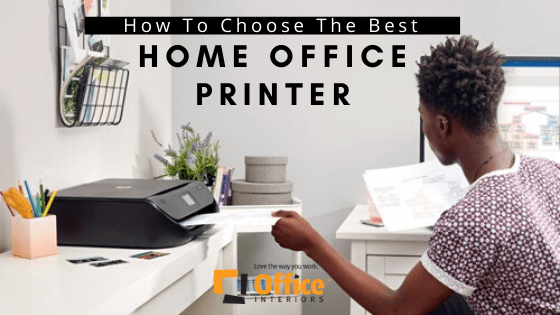Are you in the market for an at-home printing device that can meet your daily business printing needs? Not sure which printer is best suited for your workflow or your budget? Let us help you make the best decision on your next office printer by telling you the things to consider when buying a work from home officer printer.
As the need for home office supplies has increased, so has the demand for equipment that meets the needs of the average home office user. A good printer should be able to give you the best return on your investment by working more efficiently and saving you money on consumables such as ink or toner.

Make Sure It Meets Your Needs
This should be your first consideration. Investing in a home office printer that can handle the workload is an investment worth making. Be sure to ask yourself these questions first:
- Do you need to print, scan and fax from the device?
- Do you need to print colourful images or just text documents?
- What is your average print volume?
- Does your printer provider include service contracts that cover you on consumables and maintenance?
With so many options available today, we are here to help make that decision a little easier, so you can get back to being productive from your home office.
Should You Buy An Inkjet or Laser Printer?
Understanding the differences between a laser printer and an inkjet printer is important in the buying process, but which one should you buy? Both are capable of printing an image or text onto a sheet of paper and both types of printers do the job a little differently.
Inkjet Printers do as the names suggest, and use water-based ink to recreate text and images on paper. The inkjet printer applies small droplets of ink directly to the surface of the paper. The most common inkjet printers use individual ink cartridges which are combined to create different coloured inks. Using liquid ink is a better option when it comes to printing high-quality images and if your home office requires you to print colourful documents with plenty of images, then an inkjet printer is going to give you the best results.
One of the big selling points for buying an inkjet printer would be the lower upfront costs to buy the device. Inkjet printers are not as complex and less expensive to manufacture than laser printers, so they are priced accordingly. Ink Cartridges are also more expensive when compared with toner, so if you do a lot of printing at home, the total cost of ownership on an inkjet device is higher over the lifetime of the device.
A Laser Printer, on the other hand, uses a hot laser that creates static electricity inside the printer on a rolling drum. Toner ink is attracted to the electricity in the form of powder which is then melted onto the paper. Unlike an inkjet printer, a laser printer is not ideal for printing colourful, detailed images. Instead, laser printers perform best in an environment where most printing consists of text documents.
The upfront cost of a laser printer is also much more expensive than that of an inkjet printer and they are more likely to require regular maintenance. However, laser printer consumables (toner cartridges) are substantially more cost-effective than inkjet consumables. This means that the lifetime cost of a properly maintained laser printer will be less than that of an inkjet printer.
So, which one of these devices is right for the needs of your home office? If you still need more information on Inkjet vs Laser Printers, we have a list of the Pros and Cons for each.
Multifunction Printer Or Stand Alone?
If you see yourself working from home and using a home office, using a multifunction printer (MFP) would be a great idea. An MFP is a printer that can do it all! Scan important documents and save them as files, fax those documents and print all in one convenient device.
Making the choice between an MFP or standalone printer would depend on the type of work being done at home. If your office does not require the need of a scanner for making copies and the majority of the printing being done is text-based then maybe a stand-alone printer would be better suited for your needs. Choosing a stand-alone printer can also be less expensive than a multifunction printer in most cases.
How Much Does a Home Office Printer Cost?
While the cost of a particular printer or MFP may vary based on its configuration (ex. the number of paper trays) and its capabilities (ex. duplexing capability) it is possible to estimate a price range you should target.
When buying for the home office, budget between $250 to $600 for a desktop printer and between $600 to $1200 for a desktop multifunction printer (MFP). Once you move into commercial-grade printers, however, the price increases.
It’s important to remember that the total cost of ownership for even a small printer or MFP often far exceeds what you paid upfront to acquire it. You can read our in-depth article for a more thorough breakdown on How to Determine the Total Cost of Ownership for a Copier or Printer.

How Much Are Supplies?
There is an old business model mantra that goes “give away the razor, sell the blades.” That mantra is a perfect fit for the printer business, as many printer companies tempt consumers with low prices on devices while charging a premium for the replacement ink cartridges.
So what is that replacement cartridge going to cost you once it finally runs dry? This is an important question to consider before you buy just any printer. Often it is more beneficial to spend the extra on upfront cost in order to buy into the more affordable line of cartridges. This also depends on the amount of printing you will be doing in your home office.
Should You Get A Service Contract On Your Printer?
It’s important to understand what a service contract covers and what supplies could be included. A service contract will typically cover anything that is directly related to the device itself but not the network in which it operates.
The benefit of having a service contract is that you are covered for breakdown or quality issues and subsequent parts and labour. You also receive priority service over clients without a service contract. Most service contracts will also include all your toner and preventative maintenance.
An important note to keep in mind is what is not covered by a service contract. Specifically, anything that might cause a device to function poorly (or not at all) but is not a fault of the device itself. Even the best bumper to bumper warranty won’t extend beyond the car itself and neither will a service contract on your printer.
Need More Advice on your Office Printer?
At Office Interiors, we strongly believe that it is our responsibility to provide our customers with the answers and information they need to make an informed decision. We would love the opportunity to earn your business and help you love the way you work!
We aim to answer all the questions and concerns our customers might have. After reading this article, if you still have any questions regarding office workflow solutions or how to increase productivity, feel free to contact one of our team members. We’re always happy to help you on your journey to staying connected when it counts.
Our mission is to help our customers create more productive work environments.
Cody Turner
Digital Content Specialist
Office Interiors






